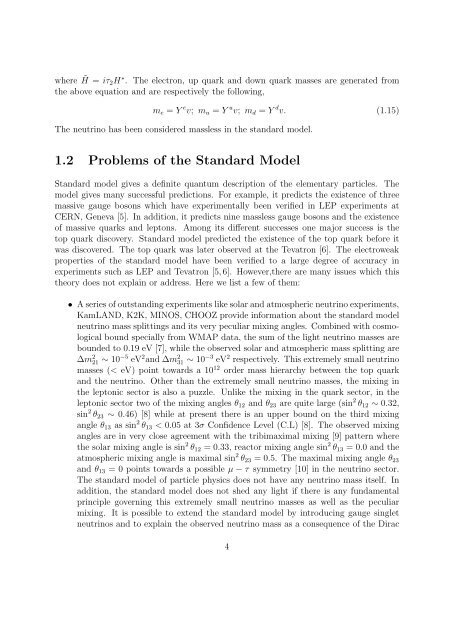PHYS08200604017 Manimala Mitra - Homi Bhabha National Institute
PHYS08200604017 Manimala Mitra - Homi Bhabha National Institute
PHYS08200604017 Manimala Mitra - Homi Bhabha National Institute
You also want an ePaper? Increase the reach of your titles
YUMPU automatically turns print PDFs into web optimized ePapers that Google loves.
where ˜H = iτ 2 H ∗ . The electron, up quark and down quark masses are generated from<br />
the above equation and are respectively the following,<br />
m e = Y e v; m u = Y u v; m d = Y d v. (1.15)<br />
The neutrino has been considered massless in the standard model.<br />
1.2 Problems of the Standard Model<br />
Standard model gives a definite quantum description of the elementary particles. The<br />
model gives many successful predictions. For example, it predicts the existence of three<br />
massive gauge bosons which have experimentally been verified in LEP experiments at<br />
CERN, Geneva [5]. In addition, it predicts nine massless gauge bosons and the existence<br />
of massive quarks and leptons. Among its different successes one major success is the<br />
top quark discovery. Standard model predicted the existence of the top quark before it<br />
was discovered. The top quark was later observed at the Tevatron [6]. The electroweak<br />
properties of the standard model have been verified to a large degree of accuracy in<br />
experiments such as LEP and Tevatron [5,6]. However,there are many issues which this<br />
theory does not explain or address. Here we list a few of them:<br />
• Aseriesofoutstandingexperimentslikesolarandatmosphericneutrinoexperiments,<br />
KamLAND, K2K, MINOS, CHOOZ provide information about the standard model<br />
neutrino mass splittings and its very peculiar mixing angles. Combined with cosmological<br />
bound specially from WMAP data, the sum of the light neutrino masses are<br />
bounded to 0.19 eV [7], while the observed solar and atmospheric mass splitting are<br />
∆m 2 21 ∼ 10 −5 eV 2 and ∆m 2 31 ∼ 10 −3 eV 2 respectively. This extremely small neutrino<br />
masses (< eV) point towards a 10 12 order mass hierarchy between the top quark<br />
and the neutrino. Other than the extremely small neutrino masses, the mixing in<br />
the leptonic sector is also a puzzle. Unlike the mixing in the quark sector, in the<br />
leptonic sector two of the mixing angles θ 12 and θ 23 are quite large (sin 2 θ 12 ∼ 0.32,<br />
sin 2 θ 23 ∼ 0.46) [8] while at present there is an upper bound on the third mixing<br />
angle θ 13 as sin 2 θ 13 < 0.05 at 3σ Confidence Level (C.L) [8]. The observed mixing<br />
angles are in very close agreement with the tribimaximal mixing [9] pattern where<br />
the solar mixing angle is sin 2 θ 12 = 0.33, reactor mixing angle sin 2 θ 13 = 0.0 and the<br />
atmospheric mixing angle is maximal sin 2 θ 23 = 0.5. The maximal mixing angle θ 23<br />
and θ 13 = 0 points towards a possible µ−τ symmetry [10] in the neutrino sector.<br />
The standard model of particle physics does not have any neutrino mass itself. In<br />
addition, the standard model does not shed any light if there is any fundamental<br />
principle governing this extremely small neutrino masses as well as the peculiar<br />
mixing. It is possible to extend the standard model by introducing gauge singlet<br />
neutrinos and to explain the observed neutrino mass as a consequence of the Dirac<br />
4
















